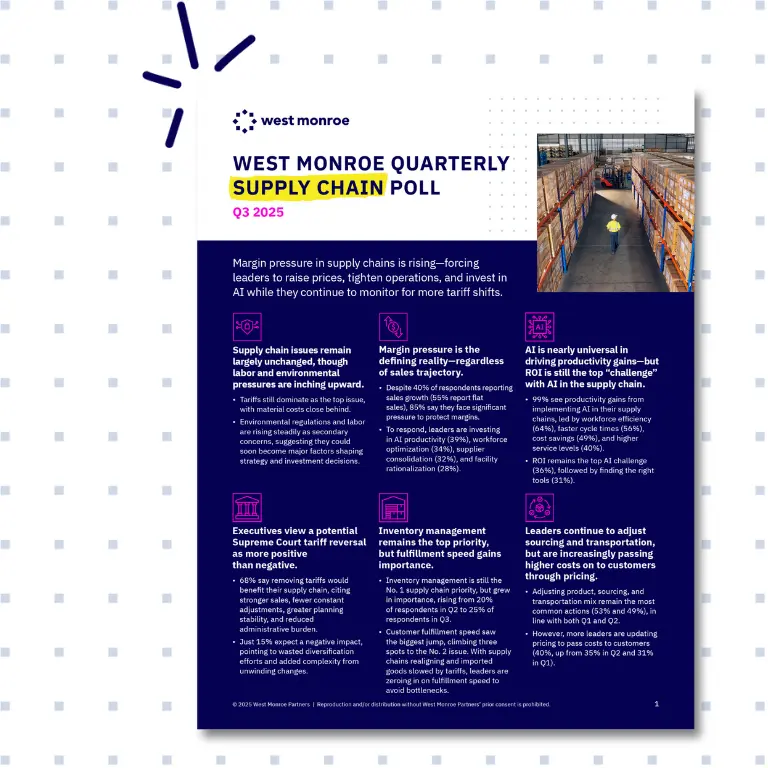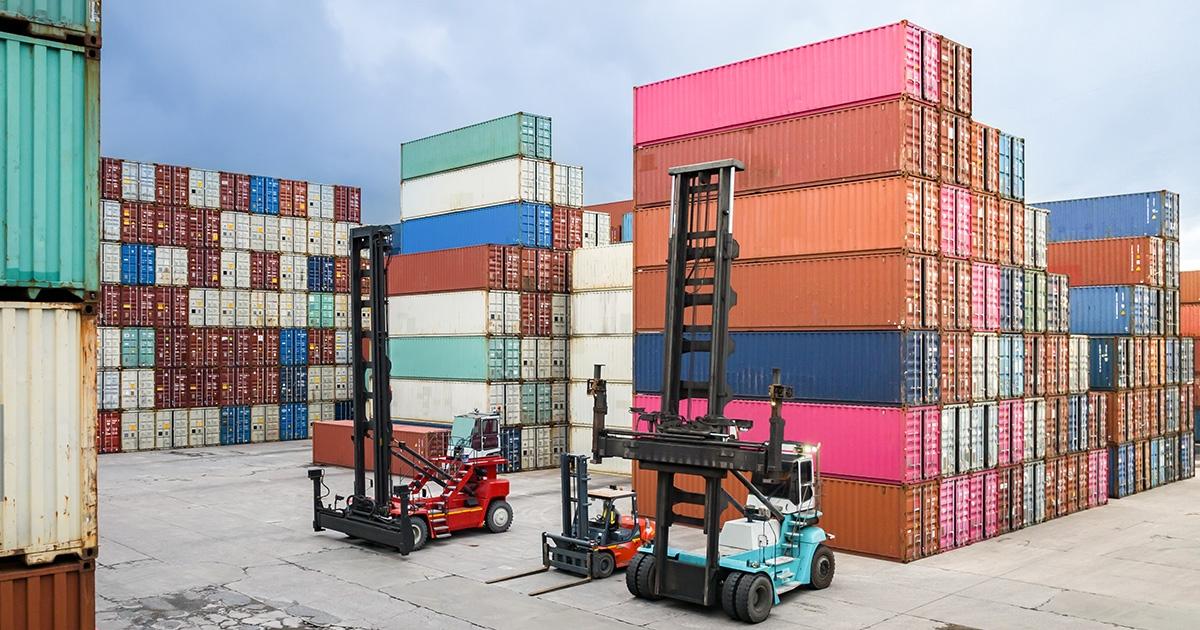Research
Q3 Poll: Margin Pressure Mounts Amid Policy Volatility and Shapes Decisions
Leaders are using pricing, supplier strategies, and AI to safeguard profitability and stay agile amid shifting tariff policies
October 08, 2025

In Q3 of West Monroe’s Quarterly Supply Chain Poll, leaders found themselves squeezed from all sides: margin pressure is escalating, even as AI increases productivity, and the Supreme Court’s potential tariff ruling looms as a wild card. Companies continue to manage for today’s issues, without the visibility and certainty to plan for the long term.

The Data Behind the Pressure Cooker: Get the Complete Picture
The Q3 results from West Monroe’s Quarterly Supply Chain Poll go deeper than what’s covered here. Download the full report to see how companies are piloting agentic AI in their supply chain operations, whether they’re experiencing positive or negative effects from Trump administration policies, and how inventory levels changed in Q3.
Tariffs, Costs, and the Growing Pressure Cooker
Tariffs and material cost pressures remain the twin anchors on supply chain angst. While these challenges are familiar, they’re now joined by growing worry over environmental regulation and labor constraints—signs that companies are not just dealing with short-term issues, but longer-term stress.
The policy backdrop intensified in Q3. In August, President Trump added a 25% penal tariff on Indian goods—on top of existing reciprocal duties—raising the total tariff on many imports from India to 50%. Then in late September, the administration announced a 100% tariff on imported branded and patented pharmaceuticals, effective October 1. While generics are excluded and companies building U.S. plants may qualify for exemptions, implementation has already been partially paused to allow for negotiation. The back-and-forth underscores how unpredictable tariff policy has become, keeping leaders on edge throughout 2025.
Against this backdrop, executives are weighing what a Supreme Court ruling on tariffs could mean. In our poll, 68% say removing tariffs would benefit their supply chains—citing stronger sales, fewer constant adjustments, greater planning stability, and reduced administrative burden. Just 15% expect a negative impact, pointing to wasted diversification efforts and added complexity from unwinding changes.
Margin Pressures Dominate as Leaders Focus on Immediate Challenges
In Q3 we introduced a new line of questioning about how leaders are experiencing margin pressure—and the results were striking. Even with 40% of firms reporting sales growth (and another 55% flat), 85% say protecting margins is their top concern. This tension is shaping real-time decision-making: leaders are leaning on pricing power, supplier consolidation, workforce optimization, and AI to hold the line.
In fact, nearly all leaders (99%) report productivity gains from applying AI to supply chains, from efficiency improvements and faster cycle times to cost savings and higher service levels. Yet ROI remains the top challenge (36%), highlighting a disconnect between the tangible operational gains and the ability to measure financial impact.
While few are making sweeping structural changes, supply chain tweaks adjustments remain common to address to challenge of the day. Adjustments to sourcing, materials, and transportation practices are consistent with Q2 levels (53% and 49%), but more leaders are now passing costs directly to customers through pricing—the clearest signal that margin defense is the battleground.
What’s Next? From Defense to Selective Offense
In Q2, we described companies executing a “tariff tap dance”—moves made in response to policy uncertainty, easily reversed if the wind shifts. In Q3, that dance continues, but the pressure is mounting. Margin stress is pushing more decisive moves. AI is no longer optional, but ROI clarity is the missing link.
Inventory control remains the anchor of supply chain priorities: 25% of respondents named it their top focus (up from 20% in Q2). The surprise mover? Customer fulfillment speed, which jumped three spots to become the No. 2 priority. As realigned supply flows and tariff-driven delays mount, speed is emerging as a competitive necessity.
Looking ahead, the next chapter will show which companies lean in and differentiate. Structural agility—data, scenario modeling, responsive networks—will matter more than ever.
About the West Monroe Quarterly Supply Chain Poll
The West Monroe Quarterly Supply Chain Poll surveys 250 industry leaders across manufacturing, retail, and distribution to track how they’re responding to disruption in real time. The survey is commissioned by West Monroe and fielded online by RepData LLC. Only director+ titles in U.S.-based companies with at least $500 million in annual revenue qualify.
West Monroe’s supply chain team is a group of experienced operators and technologists who help clients build smarter, more resilient, and data-driven supply chains. For questions about the poll, please reach out to the firm’s External Communication Director Christina Galoozis.
*The Q3 poll was taken Sept. 16-20, 2025.
*The Q2 poll was taken June 11-15, 2025.
*The Q1 poll was taken March 18-24, 2025.
Click here to download the full Q3 results.





.jpg&w=3840&q=75)